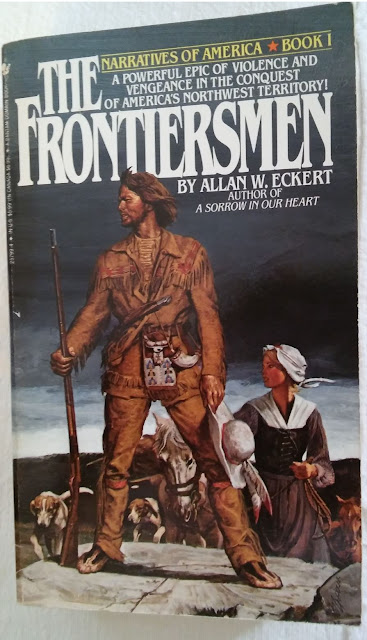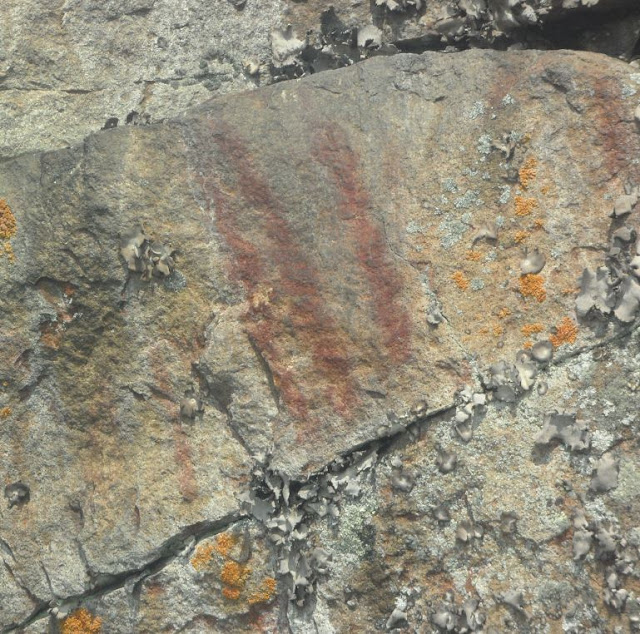The author blowing a conch-shell trumpet, picture by
the author
On the Old Northwest Frontier of the late 18th
and early 19th centuries, a trumpet made by removing the tip of a
conch shell, was a commonly used for signaling by both the Native Americans and
the European Settlers.
 |
From “The Use Of Shells By Ontario Indians”, by W. J. Wintemberg
p. 46 and p. 62
|
The author of “The Use Of Shells By Ontario Indians”,
W. J. Wintemberg, reprints the assertion by Dr. Beauchamp that “Shell trumpets were not used by N.Y. Indians
in the early days – at least not in the interior, but that there is a record of
their use in 1791”1. As
evidence of this, Dr. Beauchamp used Col. Thomas Proctor’s journey from Buffalo
Creek (today’s Buffalo, NY) via Fort Franklin (Franklin, PA) and Fort Pitt
(Pittsburgh, PA), before arriving at Philadelphia, PA.
Regarding the use of conch shell trumpets, Col.
Proctor wrote the following in his journal, near today’s Warren PA: “April 19th [1791] – O’Beel [John Abeel III or
Cornplanter] and chiefs arrived here from
the lower town and ordered their conch shell to be sounded through the village
to summon their head-men into council”2.
Additionally, Col. Proctor wrote on the “24th [June, 1791 at New
Arrow’s Town, near today’s Warren, PA] I
had no sooner arrived then the chiefs were summoned to council by the sound of
a conch shell…”3.
Contrary to Dr. Beauchamp’s assertion that there is no
evidence of conch shell trumpets being used by Native Americans in the interior
of New York and Pennsylvania before 1791, there is evidence that predates 1791. John
Woolman, writing from “Wehaloosing” (today’s Wyalusing, PA), recorded in his
journal on June 17th, 1763, the following:
“After a while
we heard a conk-shell blow several times, and then came John Curtis, and
another Indian man…”4.
There is also evidence of conch shell trumpets being
used by colonial settlers in southwestern Pennsylvania before 1791. In 1764, John Minor, who was originally from London
County, Virginia, settled in what is now Mapletown, PA, west of the Monongahela
River, on Dunkard Creek. By 1778, his
cabin was fortified and he kept a “huge
conch shell”, that was blown in times of danger, and which still existed in
1888, when the History of Greene County, Pennsylvania was printed.5
In addition, European Settlers used conch shell
trumpets on the western frontier of New York State, along the Mohawk River and
its tributaries, during the American Revolution. David Elerson, writing about the rangers, in Frontiersman
of New York, noted that “…The music
of those scouts, was produced by a conch-shell, which was carried by the
leader, and served to call the party together when they chanced to become
separated in the woods”.6
The evidence shows that conch shell trumpets were used
for signaling after the French and Indian War and during the American
Revolutionary War, by both the Native Americans and the European militia and
rangers of the Old Northwest Frontier during the late 18th and early
19th centuries.
 |
Conch shell trumpet, picture by the author
|
 |
Conch shell trumpet, picture by the author
|
 |
Conch shell trumpet, picture by the author
|
However, as a reenactor, how do you make a conch shell
into a trumpet and once it is made, how do you use it?
First, I have never made a conch shell trumpet, the
one that I used in these photos and videos had already been made into a
horn. However, I did a little research
and found out that turning a conch shell into a trumpet is really quite
simple. All you have to do is remove the
tip of the whorl, of a queen or pink conch shell [Lobatus gigas, originally known as Strombus gigas], to make a mouth piece, remove the inner spiral to
open the airway and nature has made the rest of the trumpet for you. For some web sites on how to do this go
[HERE] and [HERE].
For those who would rather have the instructions in
print, here are some “how-to-do-its” from these two videos. First, you have to have a conch shell to make
a trumpet. Wash out your shell
thoroughly and then soak it overnight in a 10% bleach solution7; rinsing
it with water in the morning. You will
want one that is at least six or seven inches long. If you get one that has been commercially
harvested for meat, it will have a hole around the fourth spiral; you will have
to plug this hole either with epoxy or with your finger when you play the conch
shell.
Next, saw or break the tip off the shell, so that there
is a small opening about the size of a US dime, this will be the mouthpiece. Depending on the size of your shell, you will
have to remove around 1” to 1¼” of the tip to make a dime-sized hole.
 |
Close-up of the mouthpiece of a conch shell trumpet,
note the removal of the inner spiral, picture by the author
|
Remove the inner spiral inside the mouthpiece with a
drill, a nail or a center punch, in order to open an airway into the shell.
Lastly, to keep from cutting your lips, smooth the
edges with a file or medium grit sandpaper.
You play a trumpet by blowing air through nearly
closed lips, making a buzzing sound, and creating a standing wave vibration in
the air inside the trumpet. This
vibration inside the conch shell is what creates the trumpeting sound at the
aperture or opening of the shell.
Making the buzzing sound with your lips to blow a
conch shell trumpet, video by the author
So if you are a modern reenactor or experimental
archeologist, who is portraying either Native Americans or European militia and
rangers in central and western Pennsylvania and New York during the late 18th
and early 19th centuries, blow that conch shell trumpet!
The author blowing a conch shell trumpet, video by the
author
For a short video that I made on this subject go
[HERE]
Notes
1 W. J. Wintemberg; “The Use Of Shells By
Ontario Indians”, Annual Archeological Report, 1907, [L.K. Cameron.
Toronto, Ontario; 1908], p. 61
2 Proctor, Col. Thomas; “Col. Proctor’s
Journal”, Pennsylvania Archives, Second Series, Vol. IV, Edited by John
B. Linn and William H. Egle, M.D. [E.K. Meyers, Harrisburg, 1890] p. 485
3 Ibid., p. 511
4 A Journal of The Life And Travels of John
Woolman, Third Edition [The School if Industry, Lindfield, 1838], p. 204
5 Bates, Samuel P.; History of Greene County,
Pennsylvania [Nelson, Rishforth & co., Chicago, 1888], p. 520-521
6 Simms, Jeptha Root; The Frontiersman of New
York: Showing Customs of the Indians, Vol. 2, [Geo. C. Riggs, Albany, NY,
1883], p. 413
7 “To make a
1:10 solution, you'll need 1
part bleach for every 9 parts
water. A good amount to start with is 1/4 cup bleach and 2¼ cups of water.” Carefully pour the bleach into the bucket first, and then
add the water.” From “How to Make Your
Own Disinfectant Bleach Solution - Verywell Health”, Sep 22, 2018
Sources
Proctor, Col. Thomas; “Col. Proctor’s Journal”, Pennsylvania
Archives, Second Series, Vol. IV, Edited by John B. Linn and William H.
Egle, M.D. [E.K. Meyers, Harrisburg, 1890] p. 485 https://books.google.com/books?id=JT8OAAAAIAAJ&pg=PA485&dq=pennsylvania+conch+shell&hl=en&sa=X&ved=0ahUKEwiT2-2QrcbiAhUhWN8KHYmrAJE4qgEQ6AEIRTAF#v=onepage&q=pennsylvania%20conch%20shell&f=false,
accessed May 30, 2019









































